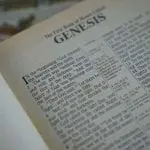[This is the fourth part in a series discussing the methodology for studying origins. The first part is entitled “The Conflict” the second part is entitled “The Evidence” and the third part is entitled “The Analysis Using the Legal-Historical Method.”]
The Starlight Problem
When studying past events, one cannot rely solely on the scientific method and philosophical reasoning. Written records are valid evidence, and they must be considered to avoid arbitrary results derived from inadequate information. The best-attested written record of history is the Bible, which includes the Genesis account. One may believe the Genesis account or one may disbelieve it. But it is inappropriate and misleading to say there is no evidence for biblical creation or that science has disproved the biblical account.
The number one reason cited by Dr. Norman Geisler for calling the Genesis account into question is the distant starlight problem. It seems to me that this is the biggest issue that is dividing the church today. All other arguments raised by evolutionists fail for insufficient evidence, but the distant starlight argument seems to be ironclad. The issue must be confronted directly because failure to do so puts well-meaning believers into the impossible position of choosing between the Word of God and what scientists claim are directly observable facts.
I am not a scientist, and I cannot speak as a scientist. What I can do, as a lawyer, is analyze the arguments and information that are provided by the scientific community. Attorneys often work with scientists specializing in forensics to reconstruct past events. It is in this capacity that I offer the following analysis and suggestions for further study.
The problem
First, we define the problem. Scientists say that the stars are more than 6,000 light-years away. Scientists also say that light is always measured to travel at a constant speed. It follows that the stars must be older than 6,000 years or they would not be visible.
As I understand it, nearly all scientists believe the stars are more than 6,000 light years away. I will therefore assume this is true, with the caveat that the Bible does not appear to equate the sun with the other stars. It is possible that the assumption that the sun is merely another star could be faulty. But assuming the stars are like the sun, and that they are more than 6,000 light years away, we come to the second issue—the constant speed of light.
 Evidence from Scripture
Evidence from Scripture
Following the legal-historical method, we first examine the historical account. The stated purpose of the stars is to give light to the earth at night. Gen. 1:16-17. The stars were made for the benefit of the inhabitants of the earth.
We must therefore infer from the text that the stars were visible on the night of the fourth day of creation. There do not appear to be any historical accounts of the gradual appearance of new stars over time. The biblical timeline appears to require starlight to reach earth instantaneously, or within a few hours at most. This seems inconsistent with the rule that the speed of light is constant. However, the burden is on science to prove that the biblical account is inaccurate.
The “constancy” of the speed of light
From the Michelson-Morley line of experiments, we are told that the speed of light is a constant. We are told this constant is an integral part of modern physics, including Maxwell’s equations.
However, the speed of light is a very unusual constant. Light does not propagate at speed c from its source, but rather, toward the observer.
Scientists measured the speed of light coming from a star when the earth was moving away from the star. They measured it again six months later when the earth was moving toward the star. Both times, they got the same speed.
This tends to prove that the speed of light cannot be constant. By definition, speed is a relative term. Speed can only be constant when both the source and the observer are stationary. Light traveling from a star toward an object moving away from the star must travel at a speed greater than c with respect to its source. This is problematic because Maxwell’s equations are based upon the permittivity and permeability of free space.
|
If the secular model is correct, light leaving a star must be able to foresee and immediately calculate: (a) which of the trillions of objects in the universe it will eventually strike, (b) where that object will be, (c) the object’s speed and direction, and possibly, (d) the object’s gravity. Having performed this calculation, the light would set itself on cruise control for the billion-year ride to its destination. Each photon leaving a star would travel at a different speed with respect to its source because each photon’s speed depends, not on the source star, but on the speed and direction of the observer. This also is inconsistent with Maxwell’s equations.
 Human activity compounds the problem. Suppose that after a ray of light left the star, but before it reached the observer, the observer began moving away from the star along the ray at a high speed. According to Michelson-Morley, the light would have to recalculate and speed up in mid-flight so that the observer would measure the incoming light at c.
Human activity compounds the problem. Suppose that after a ray of light left the star, but before it reached the observer, the observer began moving away from the star along the ray at a high speed. According to Michelson-Morley, the light would have to recalculate and speed up in mid-flight so that the observer would measure the incoming light at c.
The absurdity of these results cannot be circumvented by claims of time dilation and length contraction. The idea that time is affected by speed is easily falsified. If time stopped at the speed of light, light could not move. Secondly, under the principle of relativity, speed can be measured from any reference point. This means the observer is moving toward the light at c from the perspective of the light. Anyone who looks at their watch knows that light does not stop at the speed of light. Time cannot run at different speeds depending upon which reference point one looks toward. Objects cannot change length, volume, speed, and position merely because a different frame of reference is selected. Special relativity is a convention for reconstructing the data from faraway, fast-moving objects that is distorted due to the finite speed of light. It is not a way of explaining the fact that light is always measured to approach the observer at the same speed.
Therefore, we find that the constant measured speed of light, far from proving the secular model, actually creates serious problems for it. Is there another way of looking at the problem?
The interactive nature of light
From Young’s double-slit experiment, we learn that light is affected by attempts to measure it. Photon detectors change the way incoming light behaves. Therefore, it appears that light is interactive. In other words, it appears that a relationship exists between incoming light and an observer that begins even before the light reaches the detector.
Possible explanation
When the constant speed of light toward an observer is considered together with the interactivity of light, and Occam’s razor is applied, it may be inferred that the maximum speed of light must be something greater than c. The constant c likely represents the maximum speed at which light may approach an observer. The fact that light is always observed to approach an observer at the same speed is much more easily and naturally explained in terms of a limiting force deriving from interaction between the approaching light and the observer. Maxwell’s and Einstein’s equations indicate that the constant c is a component of the interaction between matter and energy, and electro-magnetism, among other things. Thus, Maxwell’s equations do not depend on the constant speed of light; but rather, the speed of light always appears constant because of Maxwell’s equations. Because of the interactivity between incoming light and the observer, light’s speed toward the observer becomes limited to c.
“The constant c likely represents the maximum speed at which light may approach an observer.” -Tim Newton
When light is emitted from a star, Maxwell’s equations would seem to require that the light propagates outward at c from the standpoint of the star in all directions. Yet when we measure incoming light from stars, all of which are not moving at the same speed vis-à-vis earth, we find the light always travels at c toward us. How can this be?
This seems to imply that the assumption that space is uniform from earth all the way to the stars may be incorrect. We know that light travels at different speeds in different substances, such as air and water. It may be that vast stretches of space surrounding local star systems, rather than simply being a vacuum devoid or relatively devoid of material, are in fact a type of hyperconductor that allows light to jump immediately across. The fact that stars are visible from earth or the Hubble telescope despite the separation of such incredible distances provides some support for this concept. Also, scientists say that space is expanding. If this were true, then stars, earth, people, and even molecules would expand with it. Everything in the universe would be pulled apart and reduced to subatomic particles. The fact that we do not find this happening tends to indicate that areas of space outside of star systems must be made of something other than a mere vacuum. Outer space may be composed of something of which we yet have no conception.
It does not appear that any transition of this sort has been documented by scientists. However, the Voyager spacecraft are still less than 20 light-hours from earth. The nearest stars are several light-years away. The existence of such a transition is not merely invoked to save the biblical account. It is inferred from available evidence.
Our knowledge is incomplete
The above explanation could be incorrect. I do not profess to understand the mysteries of the universe. However, it is provided as a possible alternative to demonstrate that science cannot categorically prove the biblical account of creation is incorrect.
Our knowledge of light is incomplete. Light sometimes seems to act like a particle, and sometimes like a wave. Current understanding of the speed of light begins with the irrational proposition that an inherently relative concept is in fact a cosmological constant and ends up demanding that we give up rationality altogether. Attempts to explain the experimental data have lead some scientists to resort to fanciful stories about twins aging at different rates and cats that are both dead and alive.
When God confronted Job, one of the first things God asked him was, “Where is the abode of light?” Job 38:19. God is light. I John 1:5. We should avoid invoking something God uses to describe His nature to represent to the world that He is a liar.
Christ is the light that came into our world. John 1:5-9. He laid aside His deity to become a man. Phil. 2:5-8. Could it be that light follows Christ’s example by giving up its infinite quality to serve mankind?
Scientists who believe the Bible should work together with experts from other forensic disciplines to make a concerted effort to find the correct solution to the starlight problem. What I have offered is not intended as a scientific hypothesis, but rather a method for thinking through the problem. Instead of accepting the explanations provided by modern science, which are absurd on many points, Christian apologists should examine the actual research methods and findings of each experiment and carefully think through their implications with a willingness to reject the “mainstream” model if it proves unworkable. The study of this subject is not a mere indulgence of idle curiosity, but an important service to those who are perishing under the mistaken belief that the Bible has been proven wrong by modern science. II Cor. 10:4.
Conclusion
The Church is facing an existential threat from scientists who claim the Bible cannot be trusted. Our hope is not built on a God who lies. Christianity is robbed of its power by denial of creation nearly as much as denial of the resurrection—after all, the resurrection makes possible the new creation. I Cor. 15:12-19; Gal. 5:17. How can we trust God for a new creation if He has falsely represented the original creation?
The rejection of the Genesis account of creation is not demanded by the evidence. Any comprehensive investigation of the subject of origins must begin with the testimony of God. All arguments against the accuracy of the Genesis account—including the starlight problem—are based upon assumptions that scientists cannot prove. Therefore, the Church should firmly reject those who teach that the Genesis account is false.
– Timothy J. Newton, Aug. 27, 2017








In all candor, I must point out that Dr. Jason Lisle’s new book, “The Physics of Einstein,” contradicts many of my comments in this article (Part 4 – The Starlight Problem). I ordered a copy of his book as soon as it came out and read it with interest. I will not spoil his book sales, so I refer the reader to his book for his perspective.
This article represents my opinions, of course. This was written as a “think out of the box” perspective in hopes of spurring further research into this issue.
I would like to point out that after reading Dr. Lisle’s book, I found I still have what I believe to be strong arguments against Einstein’s relativity as currently portrayed. I do not question the core principle that observers in different reference frames will see things differently due to the finite speed of light. However, I have serious doubts about certain alleged corollaries of relativity, including time dilation, length contraction, non-simultaneity, and the denial that light speed can ever exceed c.
I have composed a detailed response addressing those issues, and I have provided copies to Dr. Lisle and David Rives Ministries, which hosts this site. It is not my intention to mislead anyone. On the other hand, it is my hope that a little spirited debate may help in finding answers to this most difficult question.
-Tim Newton
This article is a classic “I do not understand it therefore it is wrong”. It is important that Christians do not make Christianity look foolish by making comments that show they do not understand science or the Bible.
Russ,
What specifically is your issue? Drive-by put-downs accomplish nothing.
I have continued to study this issue since this article was written. After re-reading the article, I would say some things slightly differently, particularly with respect to Maxwell’s equations. However, I can honestly say I haven’t seen anything that proves the position advanced in the article is incorrect. In fact, further study has convinced me that special relativity is self-contradictory. I have yet to see even one explanation of special relativity that doesn’t reduce itself to absurdity, including Einstein’s.
Tim N.
The heavens aren’t the only thing God stretched out. He stretched out the earth too (Psalm 136:6 KJV). We know the earth isn’t getting bigger with time, nor is there time dilation on earth.
This is an interesting point, but since the word “eretz” could mean “dry land” rather than having to mean the whole globe, we dare not make a dogmatic statement about the planet being stretched the way it is clear he did to the heavens.